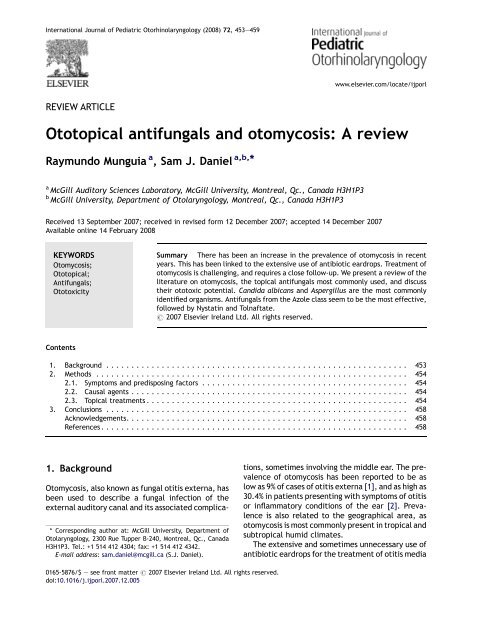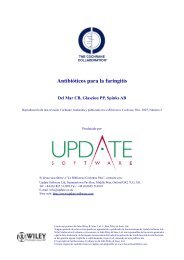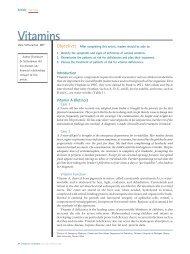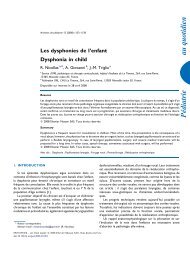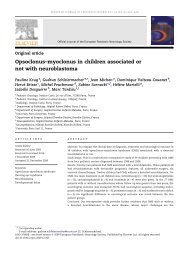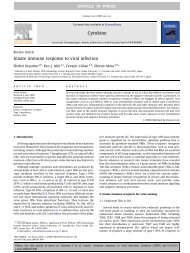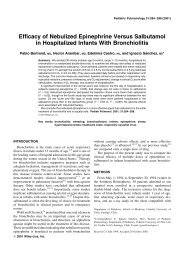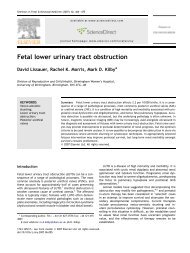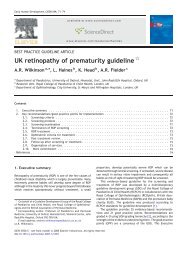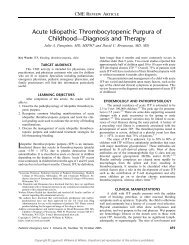Ototopical antifungals and otomycosis: A review - sepeap
Ototopical antifungals and otomycosis: A review - sepeap
Ototopical antifungals and otomycosis: A review - sepeap
You also want an ePaper? Increase the reach of your titles
YUMPU automatically turns print PDFs into web optimized ePapers that Google loves.
International Journal of Pediatric Otorhinolaryngology (2008) 72, 453—459<br />
www.elsevier.com/locate/ijporl<br />
REVIEW ARTICLE<br />
<strong>Ototopical</strong> <strong>antifungals</strong> <strong>and</strong> <strong>otomycosis</strong>: A <strong>review</strong><br />
Raymundo Munguia a , Sam J. Daniel a,b, *<br />
a McGill Auditory Sciences Laboratory, McGill University, Montreal, Qc., Canada H3H1P3<br />
b McGill University, Department of Otolaryngology, Montreal, Qc., Canada H3H1P3<br />
Received 13 September 2007; received in revised form 12 December 2007; accepted 14 December 2007<br />
Available online 14 February 2008<br />
KEYWORDS<br />
Otomycosis;<br />
<strong>Ototopical</strong>;<br />
Antifungals;<br />
Ototoxicity<br />
Summary There has been an increase in the prevalence of <strong>otomycosis</strong> in recent<br />
years. This has been linked to the extensive use of antibiotic eardrops. Treatment of<br />
<strong>otomycosis</strong> is challenging, <strong>and</strong> requires a close follow-up. We present a <strong>review</strong> of the<br />
literature on <strong>otomycosis</strong>, the topical <strong>antifungals</strong> most commonly used, <strong>and</strong> discuss<br />
their ototoxic potential. C<strong>and</strong>ida albicans <strong>and</strong> Aspergillus are the most commonly<br />
identified organisms. Antifungals from the Azole class seem to be the most effective,<br />
followed by Nystatin <strong>and</strong> Tolnaftate.<br />
# 2007 Elsevier Irel<strong>and</strong> Ltd. All rights reserved.<br />
Contents<br />
1. Background . . . . . . . . . . . . . . . . . . . . . . . . . . . . . . . . . . . . . . . . . . . . . . . . . . . . . . . . . . . . 453<br />
2. Methods . . . . . . . . . . . . . . . . . . . . . . . . . . . . . . . . . . . . . . . . . . . . . . . . . . . . . . . . . . . . . . 454<br />
2.1. Symptoms <strong>and</strong> predisposing factors . . . . . . . . . . . . . . . . . . . . . . . . . . . . . . . . . . . . . . . . . 454<br />
2.2. Causal agents . . . . . . . . . . . . . . . . . . . . . . . . . . . . . . . . . . . . . . . . . . . . . . . . . . . . . . . 454<br />
2.3. Topical treatments . . . . . . . . . . . . . . . . . . . . . . . . . . . . . . . . . . . . . . . . . . . . . . . . . . . . 454<br />
3. Conclusions . . . . . . . . . . . . . . . . . . . . . . . . . . . . . . . . . . . . . . . . . . . . . . . . . . . . . . . . . . . . 458<br />
Acknowledgements. . . . . . . . . . . . . . . . . . . . . . . . . . . . . . . . . . . . . . . . . . . . . . . . . . . . . . . . 458<br />
References . . . . . . . . . . . . . . . . . . . . . . . . . . . . . . . . . . . . . . . . . . . . . . . . . . . . . . . . . . . . . 458<br />
1. Background<br />
* Corresponding author at: McGill University, Department of<br />
Otolaryngology, 2300 Rue Tupper B-240, Montreal, Qc., Canada<br />
H3H1P3. Tel.: +1 514 412 4304; fax: +1 514 412 4342.<br />
E-mail address: sam.daniel@mcgill.ca (S.J. Daniel).<br />
Otomycosis, also known as fungal otitis externa, has<br />
been used to describe a fungal infection of the<br />
external auditory canal <strong>and</strong> its associated complications,<br />
sometimes involving the middle ear. The prevalence<br />
of <strong>otomycosis</strong> has been reported to be as<br />
low as 9% of cases of otitis externa [1], <strong>and</strong> as high as<br />
30.4% in patients presenting with symptoms of otitis<br />
or inflammatory conditions of the ear [2]. Prevalence<br />
is also related to the geographical area, as<br />
<strong>otomycosis</strong> is most commonly present in tropical <strong>and</strong><br />
subtropical humid climates.<br />
The extensive <strong>and</strong> sometimes unnecessary use of<br />
antibiotic eardrops for the treatment of otitis media<br />
0165-5876/$ — see front matter # 2007 Elsevier Irel<strong>and</strong> Ltd. All rights reserved.<br />
doi:10.1016/j.ijporl.2007.12.005
454 R. Munguia, S.J. Daniel<br />
<strong>and</strong> otitis externa has been linked to the important<br />
increase in the prevalence of <strong>otomycosis</strong>. Secondary<br />
overgrowth of fungi is a well-known <strong>and</strong> recognized<br />
complication of the use of broad-spectrum antibiotics<br />
like quinolones [3].<br />
To date, there are four main classes of drugs for<br />
the treatment of fungal infections: polyenes, triazoles,<br />
nucleoside analogues, <strong>and</strong> echinoc<strong>and</strong>ins.<br />
The polyenes family includes amphotericin B <strong>and</strong><br />
nystatin. The triazoles family, better known as<br />
azoles includes: fluconazole, clotrimazole <strong>and</strong> miconazole.<br />
The mechanism of action of the polyenes<br />
<strong>and</strong> azole families involves an essential chemical<br />
component called ergosterol found in the fungal cell<br />
membrane. The drug binds to ergosterol <strong>and</strong> creates<br />
a polar pore in the fungal membranes. This causes<br />
ions (predominantly K + <strong>and</strong> H + ) <strong>and</strong> other molecules<br />
to leak out of the cell, leading to its death. The<br />
nucleoside analogues such as flucytosine work by<br />
interfering with nucleotide synthesis; a key step in<br />
cell energy production, metabolism, <strong>and</strong> signaling.<br />
Finally, the echinoc<strong>and</strong>ins are a novel class of antifungal<br />
agents. Their mechanism of action involves<br />
interference with cell wall biosynthesis. Their use in<br />
<strong>otomycosis</strong> has not been reported.<br />
2. Methods<br />
We performed a MEDLINE search for <strong>otomycosis</strong>related<br />
articles published between January 1951<br />
<strong>and</strong> March 2007. The resulting set of 576 articles<br />
was then restricted to those using topical <strong>antifungals</strong>.<br />
Electronic search with ‘‘topical antimycotic OR<br />
<strong>otomycosis</strong> OR antifungal drops OR antifungal eardrops’’<br />
identified 96 studies, of which 18 were<br />
considered appropriate for <strong>review</strong>. Selected articles<br />
had to specify the number of patients presenting<br />
with <strong>otomycosis</strong>, the topical medication used, <strong>and</strong><br />
the efficacy of the treatment. Reviewing individual<br />
cited references identified additional studies.<br />
We present in this article a summary of the data<br />
in the literature with regards to the topical treatment<br />
of <strong>otomycosis</strong>, the treatment efficacy, <strong>and</strong> the<br />
risk of ototoxicity.<br />
2.1. Symptoms <strong>and</strong> predisposing factors<br />
The most prominent symptoms present at the time<br />
of diagnosis were: otalgia, otorrhea, hearing loss,<br />
aural fullness, pruritus, <strong>and</strong> tinnitus [1,2,4]. Very<br />
often, fungal external ear infections manifest only<br />
in the presence of predisposing factors. Some identified<br />
culprits include humid climate, presence of<br />
cerumen acting as a support for fungal growth,<br />
configuration of the ear canal, weak immune function,<br />
diabetes, increased use of ototopical antibiotics,<br />
<strong>and</strong> prolonged use of broad-spectrum<br />
antibiotics such as fluoroquinolones. Other factors<br />
that predispose patients to <strong>otomycosis</strong> include:<br />
pregnancy, use of systemic steroids, presence of<br />
open mastoid cavities, hearing aids with occlusive<br />
molds, trauma, <strong>and</strong> bacterial infections. Several<br />
recent articles have also established the potential<br />
risk of autoinoculation of the ear canal by patients<br />
suffering of dermatomycoses [1,5].<br />
2.2. Causal agents<br />
Many species of fungi have been identified as the<br />
cause of <strong>otomycosis</strong> in the literature <strong>review</strong>ed.<br />
These are listed in Table 1 along with the antifungal<br />
agent utilized for each study. Aspergillus niger <strong>and</strong><br />
C<strong>and</strong>ida albicans are the most common causative<br />
agents of <strong>otomycosis</strong>. Aspergillus is considered the<br />
predominant causal organism in tropical <strong>and</strong> subtropical<br />
regions [6]. Aspergillus niger is the most<br />
commonly described agent in the literature [7,8].<br />
Many authors believe that it is important to<br />
identify the causal agent of <strong>otomycosis</strong> in order to<br />
use the appropriate treatment. It is also recommended<br />
that the antimycotic treatment chosen<br />
should be based on the susceptibility of the identified<br />
species [9,10]. However, others believe that the<br />
most important therapeutic strategy is to select a<br />
specific treatment for <strong>otomycosis</strong> based on the<br />
efficacy <strong>and</strong> characteristics of the drug regardless<br />
of the causal agent [11,12].<br />
2.3. Topical treatments<br />
To date there is no FDA approved antifungal otic<br />
preparation for the treatment of <strong>otomycosis</strong>. Many<br />
agents with various antimycotic properties have<br />
been used, <strong>and</strong> clinicians have struggled to identify<br />
the most effective agent to treat this condition.<br />
Antifungal agents typically reach some popularity<br />
for a short period of time, until non-desirable side<br />
effects are identified or until a new medication<br />
appears on the market. However, the use of few<br />
topical <strong>antifungals</strong> has persisted throughout time,<br />
including Nystatin <strong>and</strong> the azoles family. In addition<br />
to topical therapy, the <strong>review</strong>ed literature emphasized<br />
the importance of aural hygiene in the treatment<br />
of <strong>otomycosis</strong>, as intuitively ototopical<br />
medications work best following cleaning of secretions<br />
<strong>and</strong> debris [1,13].<br />
Table 2 summarizes the studies using topical<br />
antifungal agents, the dosage utilized, <strong>and</strong> the<br />
efficacy of treatment.<br />
Azoles are synthetic agents that reduce the concentration<br />
of ergosterol, an essential sterol in the
<strong>Ototopical</strong> <strong>antifungals</strong> <strong>and</strong> <strong>otomycosis</strong> 455<br />
Table 1 Otomycosis: description of the most common causal agents <strong>and</strong> treatment<br />
Causal agent Treatment Author<br />
Aspergillus (species not specified) Clotrimazole Ologe <strong>and</strong> Nwabuisi [17]<br />
Bassiouny et al. [10]<br />
Ketoconazole Nong et al. [19]<br />
Ho et al. [1]<br />
Itraconazole Nong et al. [19]<br />
Clotrimazole Schrader (2003)<br />
Aspergillus flavus Itraconazole, terbinafide Karaarslan et al. [24]<br />
Aspergillus fumigatus Miconazole Dyckhoff et al. [21]<br />
Amphotericin B Kintzel et al. [26]<br />
Acetic acid Jackman et al. [3]<br />
Clotrimazole Jackman et al. [3]<br />
Martin et al. [13]<br />
Tolnaftate Martin et al. [13]<br />
Aspergillus niger Borneol Chang <strong>and</strong> Li [7]<br />
Tolnaftate Damato [30]<br />
Ciclopiroxolamine, boric acid del Palacio et al. [37]<br />
Itraconazole Hoshino <strong>and</strong> Matsumoto [8]<br />
Mercurochrome Mgbor <strong>and</strong> Gugnani [4]<br />
Mishra et al. [32]<br />
Boric acid Ozcan et al. [5]<br />
Clotrimazole Pradhan et al. [15]<br />
5-Fluorocytosine Than et al. [38]<br />
Itraconazole, terbinafide Karaarslan et al. [24]<br />
Fluconazole Kurnatowski <strong>and</strong> Filipiak [2]<br />
Amphotericin B Ette et al. [27]<br />
Thimerosal Tisner et al. [31]<br />
Aspergillus terreus Lanoconazole Egami et al. [14]<br />
C<strong>and</strong>ida albicans Ketoconazole Cohen <strong>and</strong> Thompson [20]<br />
Ho et al. [1]<br />
Thimerosal Tisner et al. [31]<br />
Amphotericin B Ette et al. [27]<br />
O’Day (2004)<br />
Clotrimazole Jhadav (2003)<br />
Schrader (2003)<br />
Bassiouny et al. [10]<br />
Ologe <strong>and</strong> Nwabuisi [17]<br />
Jackman et al. [3]<br />
Martin et al. [13]<br />
Itraconazole Nong et al. [19]<br />
Fluconazole Kurnatowski <strong>and</strong> Filipiak [2]<br />
Tolnaftate Martin et al. [13]<br />
Acetic acid Jackman et al. [3]<br />
C<strong>and</strong>ida parapsilosis Clotrimazole, tolnaftate Martin et al. [13]<br />
Fluconazole Kurnatowski et al. [2]<br />
Scedosporium apiospermum Clotrimazole Bhally et al. [16]<br />
Scopulariopsis brevicaulis Nystatin Besbes et al. [25]<br />
normal cytoplasmic membrane. They are a class of<br />
five-membered nitrogen heterocyclic ring compounds<br />
containing at least one other noncarbon<br />
atom, nitrogen, sulfur or oxygen [14]. Clotrimazole<br />
is the most widely used topical azole [15,16]. It<br />
appears to be one of the most effective agents<br />
for the management of <strong>otomycosis</strong>, with a reported<br />
rate of effectiveness that varies from 95% to 100% in<br />
most studies [6,10] with the exception of one study<br />
reporting a lower efficacy rate of 50% [3]. Clotrimazole<br />
has an antibacterial effect, <strong>and</strong> this is an<br />
added advantage when treating mixed bacterial—
Table 2 Otomycosis: topical treatment efficacy represented in percentage<br />
Author Study design Antifungal Posology Number of<br />
patients<br />
Jadhav et al. [6] Prospective Clotrimazole 1% solution 4 drops tid 1 month 79 100<br />
Piantoni et al. [23] Prospective Bifonazole 1% solution, once a day 4—15 days 23 100<br />
Nong et al. [19] R<strong>and</strong>omized prospective Miconazole Once a day 2 weeks 110 97.6<br />
Ketoconazole Once a day 2 weeks 97.5<br />
Clotrimazole Once a day 2 weeks 90<br />
Thymol alcohol Three times per day for 2 weeks 80<br />
Ologe <strong>and</strong> Nwabuisi [17] Prospective Clotrimazole 1% cream once a day 2 weeks 141 96<br />
Kley [18] Prospective Clotrimazole 0.25 mg/ml once a day 8—12 days 39 94.8<br />
Tisner et al. [31] Prospective Thimerosal Not reported 152 93.4<br />
Than et al. [38] Prospective 5-Fluorocytosine 10% ointment 7—10 days 189 90<br />
Ho et al. [1] Retrospective Cresylate otic Three times per day 1—3 weeks 51 86<br />
Ketoconazole otic 1—3 cc one application 1 week 48 95<br />
Aluminium acetate otic 0.5% solution 1—3 weeks 18 86<br />
Kurnatowski et al. [2] Prospective Fluconazole 0.2% solution/three times per day 21 days 96 89.4<br />
Mgbor <strong>and</strong> Gugnani [4] R<strong>and</strong>omized prospective Locacorten-vioform 1% solution every other day 7—10 days 23 66.6<br />
Mercurochrome 1% solution every other day 7—10 days 23 95.8<br />
Clotrimazole 1% solution every other day 7—10 days 24 75<br />
del Palacio et al. [37] R<strong>and</strong>omized prospective Cyclopirox olamine 11% cream 1 week 20 80<br />
Cyclopirox olamine 1% solution 1 week 20 95<br />
Boric acid 1 week 40 72.5<br />
Ozcan et al. [5] Prospective Boric acid 4% solution in alcohol 87 77<br />
Cohen <strong>and</strong> Thompson [20] Prospective Ketoconazole Not reported 9 100<br />
Jackman et al. [3] Retrospective Acetic acid otic Not reported 15 40<br />
Clotrimazole 8 50<br />
Nystatin 2 50<br />
Aluminium acetate otic 1 0<br />
Bhally et al. [16] Case report Clotrimazole 0.25 mg/ml 1 100<br />
Mishra et al. [32] Case report Mercurochrome 1% solution 1 100<br />
Dyckhoff et al. [21] Review Miconazole 0.25% solution — —<br />
Bassiouny et al. [10] In vitro Clotrimazole otic 01—4 mg/ml — 100<br />
Econazole 1% solution — 100<br />
Miconazole 0.1—4 mg/ml — 90<br />
Cyclopirox olamine otic Not reported — 57<br />
Egami et al. [14] In vitro Lanoconazole 0.1 mg/ml — 100<br />
Efficacy<br />
(%)<br />
456 R. Munguia, S.J. Daniel
<strong>Ototopical</strong> <strong>antifungals</strong> <strong>and</strong> <strong>otomycosis</strong> 457<br />
fungal infections. It is considered free of ototoxic<br />
effects [17,18]. There are no reports of clinical<br />
evidence of clotrimazole ototoxicity. Clotrimazole<br />
is available as a powder, a lotion, <strong>and</strong> a solution.<br />
Ketoconazole <strong>and</strong> fluconazole are azole antifungal<br />
agents that have a broad spectrum of activity.<br />
This family of chemical components is effective in<br />
treating the most common etiological agents of<br />
<strong>otomycosis</strong>. Ketoconazole has shown an efficacy<br />
of 95—100% in vitro against Aspergillus species<br />
<strong>and</strong> C<strong>and</strong>ida albicans; it is available as a 2% cream.<br />
[1,19,20]. Topical fluconazole has been reported<br />
effective in 90% of cases in several series. Fluconazole<br />
suspension is available with either 350 mg or<br />
1400 mg of fluconazole. After reconstitution with<br />
24 ml of distilled water or purified water (USP), each<br />
Table 3 Otomycosis treatment <strong>and</strong> risk of ototoxicity<br />
Antifungal Tested for ototoxicity Author<br />
5-fluorocytosine Not tested Than et al. [38]<br />
Acetic acid otic Ototoxic Jackman et al. [3]<br />
Jinn et al. [36]<br />
Aluminium acetate otic Non ototoxic Ho et al. [1]<br />
Jackman et al. [3]<br />
Amphotericin B Not tested Nong et al. [19]<br />
Bifonazole Not tested Piantoni et al. [23]<br />
Boric Acid Ototoxic del Palacio et al. [37]<br />
Ozcan et al. [5]<br />
Clotrimazole Non ototoxic Bhally et al. [16]<br />
Jackman et al. [3]<br />
Tom [29]<br />
Mgbor <strong>and</strong> Gugnani [4]<br />
Ologe <strong>and</strong> Nwabuisi [17]<br />
Bassiouny et al. [10]<br />
Jadhav et al. [6]<br />
Cresylate otic Ototoxic Ho et al. [1]<br />
Cyclopirox olamine 1% otic Not tested Bassiouny et al. [10]<br />
del Palacio et al. [37]<br />
Cyclopirox olamine 11% otic Not tested del Palacio et al. [37]<br />
Econazole Not tested Bassiouny et al. [10]<br />
Fluconazole Non ototoxic Kurnatowski et al. [2]<br />
Nong et al. [19]<br />
Itraconazole Not tested Nong et al. [19]<br />
Ketoconazole Non ototoxic Cohen <strong>and</strong> Thompson [20]<br />
Nong et al. [19]<br />
Ho et al. [1]<br />
Lanoconazole Not tested Egami et al. [14]<br />
Locacorten-vioform Ototoxic Mgbor <strong>and</strong> Gugnani [4]<br />
Mercurochrome 1% Non ototoxic (FDA banned) Mgbor <strong>and</strong> Gugnani [4]<br />
Mishra et al. [32]<br />
Miconazole Non ototoxic Bassiouny et al. [10]<br />
Dyckhoff et al. [21]<br />
Nystatin Not tested Jackman et al. [3]<br />
Gentian Violet Ototoxic Tom [29]<br />
Sp<strong>and</strong>ow [35]<br />
Thimerosal Not tested Tisner et al. [31]<br />
The bolded text refers to drugs that have been classified in the literature as non-ototoxic (safe). The italic text refers to drug that<br />
have been classified as ototoxic (non-safe).
458 R. Munguia, S.J. Daniel<br />
ml of reconstituted suspension contains 10 mg or<br />
40 mg of fluconazole [2,13]. Miconazole cream 2%<br />
has also demonstrated an efficacy rate of 90%<br />
[10,21]. Bifonazole is an antifungal agent that was<br />
commonly used in the 1980s. The antifungal potency<br />
of bifonazole 1% solution has been reported to be<br />
similar to that of clotrimazole <strong>and</strong> miconazole;<br />
however, it varies from species to species. Bifonazole<br />
<strong>and</strong> derivatives inhibited the growth of most<br />
fungi with an efficacy of up to 100% [22,23].<br />
Nystatin is a polyene macrolide antibiotic that<br />
inhibits sterol synthesis in the cytoplasmic membrane<br />
[24]. Many molds <strong>and</strong> yeasts are sensitive to<br />
nystatin, including C<strong>and</strong>ida species. A major advantage<br />
of nystatin is the fact that it is not absorbed<br />
across intact skin. Nystatin is not available as an otic<br />
preparation; however it can be prepared as a solution<br />
or a suspension for the treatment of <strong>otomycosis</strong>.<br />
Nystatin can be administered as a cream, an<br />
ointment, or a powder. Reported efficacy rates vary<br />
from 50% to 80% [3,25].<br />
Amphotericin B is a member of the polyenes<br />
family. It has been replaced by safer agents in most<br />
cases but is still used, despite its side effects, for<br />
life-threatening fungal infections. Nong in 1999<br />
reported that Aspergillus <strong>and</strong> C<strong>and</strong>ida albicans were<br />
sensitive to the use amphotericin B as demonstrated<br />
in antifungal susceptibility tests [19,26,27].<br />
Tolnaftate acts by distorting hyphae <strong>and</strong> inhibiting<br />
the mycelial growth of susceptible fungi that<br />
cause skin infections, including tinea pedis (athlete’s<br />
foot), tinea cruris (jock itch), <strong>and</strong> ringwormit.<br />
It has been recommended in refractory cases of<br />
<strong>otomycosis</strong>, <strong>and</strong> was shown to be non-ototoxic<br />
[28,29]. Tolnaftate is available as a 1% solution that<br />
can be easily instilled into the ear [30].<br />
In recent years, there have been attempts to use<br />
Mercurochrome, a well-known topical antiseptic, to<br />
treat <strong>otomycosis</strong>. Along with merthiolate (thimerosal),<br />
mercurochrome is no longer approved by the<br />
FDA due to the fact that it contains mercury. Tisner<br />
in 1995 reported an efficacy of 93.4% with the use of<br />
thimerosal (merthiolate) for the treatment of <strong>otomycosis</strong><br />
[31]. Mercurochrome has been used specifically<br />
for cases reported in humid environments<br />
with a reported efficacy rate between 95.8% <strong>and</strong><br />
100% [32,4].<br />
Gentian Violet is typically prepared as a weak<br />
(e.g. 1%) solution in water. It has been used since the<br />
1940s to treat <strong>otomycosis</strong> as it is an aniline dye with<br />
antiseptic, anti-inflammatory, antibacterial, <strong>and</strong><br />
antifungal activity. It is still in use in some countries,<br />
<strong>and</strong> is FDA approved. Studies report an efficacy rate<br />
of up to 80%. [20,33—35].<br />
Other available topical medications for the treatment<br />
of <strong>otomycosis</strong> reported in the literature<br />
include cyclopirox olamine, boric acid, <strong>and</strong> 5-fluorocytocine<br />
[36]. Cyclopirox acts by chelating polyvalent<br />
cations (Fe 3+ or Al 3+ ) resulting in inhibition of<br />
the metal-dependent enzymes that are responsible<br />
for the degradation of peroxides within the fungal<br />
cell. Boric acid is a mild acid often used as an<br />
antiseptic, <strong>and</strong> insecticide. Boric acid can be used<br />
to treat yeast <strong>and</strong> fungal infections such as vaginal<br />
yeast infections caused by C<strong>and</strong>ida albicans. Itis<br />
also used to prevent athlete’s foot.<br />
5-Fluorocytocine (also known as flucytosine) acts<br />
penetrating fungal cells <strong>and</strong> is converted to fluorouracil,<br />
which competes with uracil interfering with<br />
fungal RNA <strong>and</strong> protein synthesis [37,5,38]. Table 3<br />
lists the ototoxicity potential for some of the <strong>antifungals</strong>.<br />
3. Conclusions<br />
Many species of fungi have been identified as a cause<br />
of <strong>otomycosis</strong> with Aspergillus niger <strong>and</strong> C<strong>and</strong>ida<br />
albicans being the most common culprits.<br />
Overall <strong>antifungals</strong> from the azoles class such as<br />
clotrimazole, fluconazole, ketoconazole <strong>and</strong> miconazole<br />
are more effective, followed by nystatin <strong>and</strong><br />
tolnaftate.<br />
Our <strong>review</strong> of the literature did not reveal any<br />
case reports of <strong>antifungals</strong> ototopical medication<br />
causing ototoxicity when used to treat <strong>otomycosis</strong><br />
with an intact tympanic membrane. Less data exists<br />
regarding the safety of the use of ototopical medications<br />
in the presence of a tympanic membrane<br />
perforation.<br />
Acknowledgements<br />
The authors wish to thank Ms Françoise Brosseau-<br />
Lapré for her assistance, <strong>and</strong> for editing the manuscript.<br />
References<br />
[1] T. Ho, J.T. Vrabec, D. Yoo, N.J. Coker, Otomycosis: clinical<br />
features <strong>and</strong> treatment implications, Otolaryngol Head Neck<br />
Surg 135 (2006) 787—791.<br />
[2] P. Kurnatowski, A. Filipiak, Otomycosis: prevalence, clinical<br />
symptoms, therapeutic procedure, Mycoses 44 (2001) 472—<br />
479.<br />
[3] A. Jackman, R. Ward, M. April, J. Bent, Topical antibiotic<br />
induced <strong>otomycosis</strong>, Int J Pediatr Otorhinolaryngol 69 (2005)<br />
857—860.<br />
[4] N. Mgbor, H.C. Gugnani, Otomycosis in Nigeria: treatment<br />
with mercurochrome, Mycoses 44 (2001) 395—397.
<strong>Ototopical</strong> <strong>antifungals</strong> <strong>and</strong> <strong>otomycosis</strong> 459<br />
[5] K.M. Ozcan, M. Ozcan, A. Karaarslan, F. Karaarslan, Otomycosis<br />
in Turkey: predisposing factors, aetiology <strong>and</strong> therapy,<br />
J Laryngol Otol 117 (2003) 39—42.<br />
[6] V.J. Jadhav, M. Pal, G.S. Mishra, Etiological significance of<br />
C<strong>and</strong>ida albicans in otitis externa, Mycopathologia 156<br />
(2003) 313—315.<br />
[7] S.P. Chang, Y.C. Li, Observation of cell ultrastructuse in<br />
suppurative otitis media treated with bosneol <strong>and</strong> application,<br />
Zhongguo Zhong Yao Za Zhi 25 (2000) 306—308.<br />
[8] T. Hoshino, M. Matsumoto, Otomycosis: subdermal growth in<br />
calcified mass, Eur Arch Otorhinolaryngol 263 (2006) 875—<br />
878.<br />
[9] R.R. Arthur, R.H. Drew, J.R. Perfect, Novel modes of antifungal<br />
drug administration, Expert Opin Investig Drugs 13<br />
(2004) 903—932.<br />
[10] A. Bassiouny, T. Kamel, M.K. Moawad, D.S. Hindawy, Broad<br />
spectrum antifungal agents in <strong>otomycosis</strong>, J Laryngol Otol<br />
100 (1986) 867—873.<br />
[11] J. Araiza, P. Canseco, A. Bonifaz, Otomycosis: clinical <strong>and</strong><br />
mycological study of 97 cases, Rev Laryngol Otol Rhinol<br />
(Bord) 127 (2006) 251—254.<br />
[12] C.C. Blyth, P. Palasanthiran, T.A. O’Brien, Antifungal therapy<br />
in children with invasive fungal infections: a systematic<br />
<strong>review</strong>, Pediatrics 119 (2007) 772—784.<br />
[13] T.J. Martin, J.E. Kerschner, V.A. Flanary, Fungal causes of<br />
otitis externa <strong>and</strong> tympanostomy tube otorrhea, Int J<br />
Pediatr Otorhinolaryngol 69 (2005) 1503—1508.<br />
[14] T. Egami, M. Noguchi, S. Ueda, Mycosis in the ear, nose <strong>and</strong><br />
throat, Nihon Ishinkin Gakkai Zasshi 44 (2003) 277—283.<br />
[15] B. Pradhan, N.R. Tuladhar, R.M. Amatya, Prevalence of<br />
<strong>otomycosis</strong> in outpatient department of otolaryngology in<br />
Tribhuvan University Teaching Hospital, Kathm<strong>and</strong>u, Nepal,<br />
Ann Otol Rhinol Laryngol 112 (2003) 384—387.<br />
[16] H.S. Bhally, C. Shields, S.Y. Lin, W.G. Merz, Otitis caused by<br />
Scedosporium apiospermum in an immunocompetent child,<br />
Int J Pediatr Otorhinolaryngol 68 (2004) 975—978.<br />
[17] F.E. Ologe, C. Nwabuisi, Treatment outcome of <strong>otomycosis</strong> in<br />
Ilorin, Nigeria, West Afr J Med 21 (2002) 34—36.<br />
[18] E. Kley, A contribution to the treatment of otomycoses<br />
(author’s transl), Laryngol Rhinol Otol 55 (1976) 765—767.<br />
[19] H. Nong, J. Li, G. Huang, D. Nong, P. Cheng, C. Yao, The<br />
observation of mycology <strong>and</strong> clinical efficacy in 325 cases<br />
with <strong>otomycosis</strong>, Lin Chuang Er Bi Yan Hou Ke Za Zhi 13<br />
(1999) 438—440.<br />
[20] S.R. Cohen, J.W. Thompson, Otitic c<strong>and</strong>idiasis in children:<br />
an evaluation of the problem <strong>and</strong> effectiveness of ketoconazole<br />
in 10 patients, Ann Otol Rhinol Laryngol 99 (1990)<br />
427—431.<br />
[21] G. Dyckhoff, T. Hoppe-Tichy, R. Kappe, A. Dietz, Antimycotic<br />
therapy in <strong>otomycosis</strong> with tympanic membrane perforation,<br />
Hno 48 (2000) 18—21.<br />
[22] H. Yamaguchi, K. Okamoto, M. Shooji, M. Morimatsu, S.<br />
Hirai, A case of adult type sialidosis with partial betagalactosidase<br />
deficiency without myoclonus, Rinsho Shinkeigaku<br />
23 (1983) 1—8.<br />
[23] S. Piantoni, S. Narne, R. Bottin, A. Solazzo, W. Bianchi, 1%<br />
bifonazole lotion in the therapy of <strong>otomycosis</strong>, Clin Ter 130<br />
(1989) 23—27.<br />
[24] A. Karaarslan, S. Arikan, M. Ozcan, K.M. Ozcan, In vitro<br />
activity of terbinafine <strong>and</strong> itraconazole against Aspergillus<br />
species isolated from <strong>otomycosis</strong>, Mycoses 47 (2004) 284—<br />
287.<br />
[25] M. Besbes, F. Makni, F. Cheikh-Rouhou, H. Sellami, K. Kharrat,<br />
A. Ayadi, Otomycosis due to Scopulariopsis brevicaulis,<br />
Rev Laryngol Otol Rhinol (Bord) 123 (2002) 77—78.<br />
[26] P.E. Kintzel, D.E. Trausch, A.L. Copfer, Otic administration of<br />
amphotericin B 0.25% in sterile water, Ann Pharmacother 28<br />
(1994) 333—335.<br />
[27] A. Ette, M. Bamba, P. Adjoua, J. Boguifo, E.E. Ette, K. Fakhry,<br />
et al., Mycoses in otorhinolaryngology. Apropos of 167 cases,<br />
Rev Laryngol Otol Rhinol (Bord) 110 (1989) 173—177.<br />
[28] R.R. Marsh, L.W. Tom, Ototoxicity of antimycotics, Otolaryngol<br />
Head Neck Surg 100 (1989) 134—136.<br />
[29] L.W. Tom, Ototoxicity of common topical antimycotic preparations,<br />
Laryngoscope 110 (2000) 509—516.<br />
[30] P.J. Damato, Therapy with tolnaftate in <strong>otomycosis</strong> due to<br />
Aspergillus niger, Minerva Med 64 (1973) 24—26.<br />
[31] J. Tisner, J. Millan, P. Rivas, I. Adiego, A. Castellote, H. Valles,<br />
Otomycosis <strong>and</strong> topical application of thimerosal: study of 152<br />
cases, Acta Otorrinolaringol Esp 46 (1995) 85—89.<br />
[32] G.S. Mishra, N. Mehta, M. Pal, Chronic bilateral <strong>otomycosis</strong><br />
caused by Aspergillus niger, Mycoses 47 (2004) 82—84.<br />
[33] K.O. Paulose, S. Al Khalifa, P. Shenoy, R.K. Sharma, Mycotic<br />
infection of the ear (<strong>otomycosis</strong>): a prospective study, J<br />
Laryngol Otol 103 (1989) 30—35.<br />
[34] T.L. Lawrence, L.W. Ayers, W.H. Saunders, Drug therapy in<br />
<strong>otomycosis</strong>: an in vitro study, Laryngoscope 88 (1978) 1755—<br />
1760.<br />
[35] O. Sp<strong>and</strong>ow, M. Anniko, A.R. Moller, The round window as<br />
access route for agents injurious to the inner ear, Am J<br />
Otolaryngol 9 (1988) 327—335.<br />
[36] T.H. Jinn, P.D. Kim, P.T. Russell, C.A. Church, E.O. John, T.T.<br />
Jung, Determination of ototoxicity of common otic drops<br />
using isolated cochlear outer hair cells, Laryngoscope 111<br />
(2001) 2105—2108.<br />
[37] A. del Palacio, M.S. Cuetara, M.J. Lopez-Suso, E. Amor, M.<br />
Garau, R<strong>and</strong>omized prospective comparative study: shortterm<br />
treatment with ciclopiroxolamine (cream <strong>and</strong> solution)<br />
versus boric acid in the treatment of <strong>otomycosis</strong>, Mycoses 45<br />
(2002) 317—328.<br />
[38] K.M. Than, K.S. Naing, M. Min, Otomycosis in Burma, <strong>and</strong> its<br />
treatment, Am J Trop Med Hyg 29 (1980) 620—623.<br />
Available online at www.sciencedirect.com


